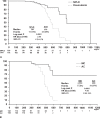Anthracycline-induced cardiotoxicity and the cardiac-sparing effect of liposomal formulation
- PMID: 18203425
- PMCID: PMC2676818
Anthracycline-induced cardiotoxicity and the cardiac-sparing effect of liposomal formulation
Abstract
The anthracyclines are a group of antibiotics that are among the most potent chemotherapeutic agents. They are highly effective against a broad spectrum of malignancies, including lymphoma, gastric cancer, small cell lung cancer, sarcoma, and breast cancer. Unfortunately, these agents also exhibit a well-recognized cumulative-dose related cardiotoxic profile that limits the extent to which they can be used safely. In clinical practice, most clinicians limit the cumulative dose of doxorubicin (the most widely used agent in this group) to 400-450 mg/m2, but considerable cardiac damage is now known to occur at cumulative dosages considerably below this level. Regimens using newer combinations of agents, the most widely studied of which is the monoclonal antibody trastuzumab, are known to augment the cardiotoxicity of anthracyclines. The application of nanotechnology to medicine involves the use of devices that will interact with the body at the molecular level. These methods can lead to target and tissue specific clinical application, often with minimal or reduced side effects. Liposomal preparations incorporate such technology, thereby altering some important characteristics of the parent compound and facilitating concentration at the tumor site. In the case of liposomal doxorubicin, cardiotoxicity is reduced significantly. This review summarizes the important information on the liposomal preparation of anthracyclines.
Figures



References
-
- Al-Nasser IA. In vivo prevention of adriamycin cardiotoxicity by cyclosporin A or FK506. Toxicology. 1998;131:175–81. - PubMed
-
- Ali MK, Ewer MS, Gibbs HR, et al. Late doxorubicin-associated cardiotoxicity in children. The possible role of intercurrent viral infection. Cancer. 1994;74:182–8. - PubMed
-
- Allen TM, Martin FJ. Advantages of liposomal delivery systems for anthracyclines. Semin Oncol. 2004;31:5–15. - PubMed
-
- Andrieu-Abadie N, Jaffrezou JP, Hatem S, et al. L-carnitine prevents doxorubicin-induced apoptosis of cardiac myocytes: role of inhibition of ceramide generation. Faseb J. 1999;13:1501–10. - PubMed
-
- [Anon] Favourable and unfavourable effects on long-term survival of radiotherapy for early breast cancer: an overview of the randomised trials. Early Breast Cancer Trialists’ Collaborative Group. Lancet. 2000;355:1757–70. - PubMed
Publication types
MeSH terms
Substances
LinkOut - more resources
Full Text Sources
Other Literature Sources
Medical

